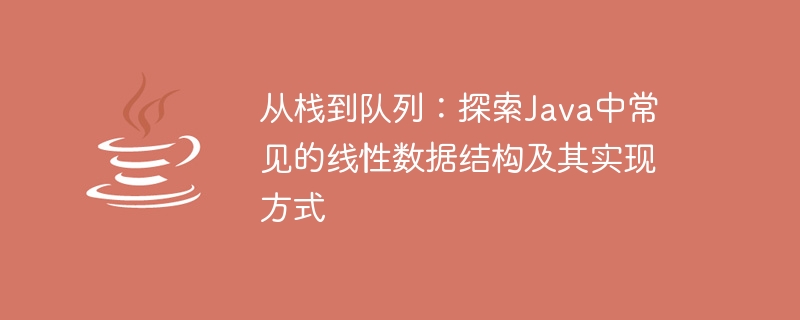Java中常見的線性資料結構及其實作方式:從堆疊到佇列的探索
- WBOYWBOYWBOYWBOYWBOYWBOYWBOYWBOYWBOYWBOYWBOYWBOYWB原創
- 2023-12-26 16:55:121202瀏覽

從堆疊到佇列:探索Java中常見的線性資料結構及其實作方式
引言:
在電腦科學中,資料結構是組織和儲存資料的一種方式。線性資料結構是其中之一,它的特徵是資料元素之間存在明確的前後關係。在Java開發中,常見的線性資料結構包括堆疊和佇列,它們的使用頻率非常高。本文將深入探索堆疊和佇列在Java中的實作方式,並提供具體的程式碼範例。
一、堆疊的概念及實作方式:
堆疊是一種後進先出(Last In First Out, LIFO)的資料結構。它的特點是只能在堆疊頂部進行插入和刪除操作。在Java中,堆疊的常見實作方式有兩種:基於陣列的實作和基於鍊錶的實作。
- 基於陣列的堆疊實作:
陣列是一種連續儲存的資料結構,非常適合用來實作堆疊。以下是一個基於陣列的堆疊類別的範例程式碼:
public class ArrayStack {
private int[] stack;
private int top; // 栈顶指针
public ArrayStack(int capacity) {
stack = new int[capacity];
top = -1;
}
public boolean isEmpty() {
return top == -1;
}
public boolean isFull() {
return top == stack.length - 1;
}
public void push(int item) {
if (isFull()) {
throw new RuntimeException("Stack is full");
}
stack[++top] = item;
}
public int pop() {
if (isEmpty()) {
throw new RuntimeException("Stack is empty");
}
return stack[top--];
}
public int peek() {
if (isEmpty()) {
throw new RuntimeException("Stack is empty");
}
return stack[top];
}
}- 基於鍊錶的堆疊實作:
鍊錶是一種非連續儲存的資料結構,同樣適合用來實現棧。以下是一個基於鍊錶的堆疊類別的範例程式碼:
public class LinkedStack {
private Node top;
public LinkedStack() {
top = null;
}
public boolean isEmpty() {
return top == null;
}
public void push(int item) {
Node newNode = new Node(item);
newNode.next = top;
top = newNode;
}
public int pop() {
if (isEmpty()) {
throw new RuntimeException("Stack is empty");
}
int item = top.data;
top = top.next;
return item;
}
public int peek() {
if (isEmpty()) {
throw new RuntimeException("Stack is empty");
}
return top.data;
}
private class Node {
private int data;
private Node next;
public Node(int data) {
this.data = data;
this.next = null;
}
}
}二、佇列的概念及實作方式:
佇列是一種先進先出(First In First Out, FIFO)的資料結構。它的特點是只能在隊尾插入元素,在隊頭刪除元素。在Java中,佇列的常見實作方式有兩種:基於陣列的實作和基於鍊錶的實作。
- 基於陣列的佇列實作:
與基於陣列的堆疊實作類似,下面是一個基於陣列的佇列類別的範例程式碼:
public class ArrayQueue {
private int[] queue;
private int front; // 队头指针
private int rear; // 队尾指针
public ArrayQueue(int capacity) {
queue = new int[capacity + 1]; // 额外预留一个空位
front = rear = 0;
}
public boolean isEmpty() {
return front == rear;
}
public boolean isFull() {
return (rear + 1) % queue.length == front;
}
public void enqueue(int item) {
if (isFull()) {
throw new RuntimeException("Queue is full");
}
queue[rear] = item;
rear = (rear + 1) % queue.length;
}
public int dequeue() {
if (isEmpty()) {
throw new RuntimeException("Queue is empty");
}
int item = queue[front];
front = (front + 1) % queue.length;
return item;
}
public int peek() {
if (isEmpty()) {
throw new RuntimeException("Queue is empty");
}
return queue[front];
}
}- 基於鍊錶的佇列實作:
與基於鍊錶的堆疊實作類似,下面是一個基於鍊錶的佇列類別的範例程式碼:
public class LinkedQueue {
private Node front; // 队头指针
private Node rear; // 队尾指针
public LinkedQueue() {
front = null;
rear = null;
}
public boolean isEmpty() {
return front == null;
}
public void enqueue(int item) {
Node newNode = new Node(item);
if (isEmpty()) {
front = newNode;
rear = newNode;
} else {
rear.next = newNode;
rear = newNode;
}
}
public int dequeue() {
if (isEmpty()) {
throw new RuntimeException("Queue is empty");
}
int item = front.data;
front = front.next;
if (front == null) {
rear = null;
}
return item;
}
public int peek() {
if (isEmpty()) {
throw new RuntimeException("Queue is empty");
}
return front.data;
}
private class Node {
private int data;
private Node next;
public Node(int data) {
this.data = data;
this.next = null;
}
}
}結論:
堆疊和佇列是Java中常用的線性資料結構,有多種實作方式。本文介紹了基於陣列和基於鍊錶的堆疊、佇列實現,並提供了具體的程式碼範例。開發者可以根據實際需求選擇合適的實作方式,以提高程式的效率和可維護性。
以上是Java中常見的線性資料結構及其實作方式:從堆疊到佇列的探索的詳細內容。更多資訊請關注PHP中文網其他相關文章!
陳述:
本文內容由網友自願投稿,版權歸原作者所有。本站不承擔相應的法律責任。如發現涉嫌抄襲或侵權的內容,請聯絡admin@php.cn
上一篇:java定時器怎麼設定時間下一篇:java定時器怎麼設定時間

